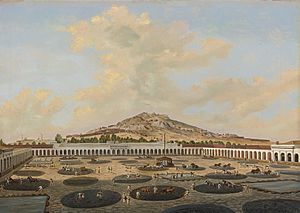
The patio process is a process for extracting silver from ore. Smelting, or refining, is most often necessary because silver is only infrequently found as a native element like some metals nobler than the redox couple 2 H+ + 2 e−⇌ H
2 (gold, mercury, ...). Instead, it is made up of a larger ore body. Thus, smelting, or refining, is necessary to reduce the compound containing the Ag+ cation into metallic Ag and to remove other byproducts to get at pure silver.[1] The process, which uses mercury amalgamation to recover silver from ore, was first used at scale by Bartolomé de Medina in Pachuca, Mexico, in 1554.[2] It replaced smelting as the primary method of extracting silver from ore at Spanish colonies in the Americas. Although some knowledge of amalgamation techniques were likely known since the classical era, it was in the New World that it was first used on a large industrial scale.[3] Other amalgamation processes were later developed, importantly the pan amalgamation process, and its variant, the Washoe process. The silver separation process generally differed from gold parting and gold extraction, although amalgamation with mercury is also sometimes used to extract gold. While gold was often found in the Americas as a native metal or alloy, silver was often found as a compound such as silver chloride and silver sulfide, and therefore required mercury amalgamation for refinement.[4]
- ^ Guerrero, Saul (2017). Silver by Fire, Silver by Mercury. A Chemical History of Silver Refining in New Spain and Mexico, 16th to 19th Centuries. BRILL. ISBN 978-90-04-34383-2. OCLC 1036776604.
- ^ Alan Probert, "Bartolomé de Medina: The Patio Process and the Sixteenth Century Silver Crisis" in Bakewell, Peter, ed. Mines of Silver and Gold in the Americas. Variorum: Brookfield, 1997, p. 96.
- ^ Bakewell, Peter (1984), "Mining in colonial Spanish America", in Bethell, Leslie (ed.), Volume 2: Colonial Latin America, The Cambridge History of Latin America, vol. 2, Cambridge: Cambridge University Press, pp. 105–152, doi:10.1017/chol9780521245166.005, ISBN 978-0-521-24516-6, retrieved 2020-12-07
- ^ Bakewell, 109.